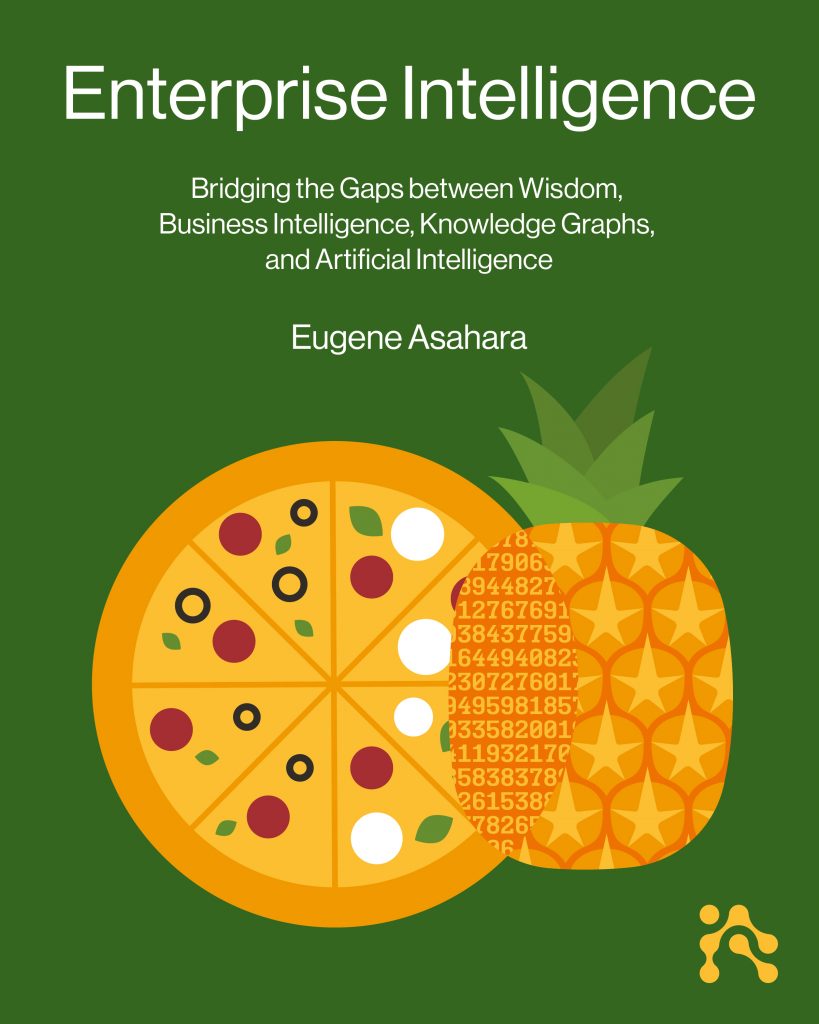
Every once in a while, a book comes along that contains such innovative ideas that I find myself whispering “wow” and “interesting” as I read through the pages. “Enterprise Intelligence,” by Eugene Asahara, is one such book. Eugene takes three basic ingredients that are not so new (business intelligence, knowledge graphs, and large language models), and combines them together in a recipe I have never seen before. Taking this food analogy one more sentence further, the result is a delicacy entirely new for our palates.
“Enterprise Intelligence” is a big book. There is a lot of content in the three ingredients, and there is even more dedicated to how they work together. Eugene explains things very clearly and reinforces the explanations with lots of examples and wonderful analogies. His humor also comes through the writing. For example, I love anything chocolate-related, and Eugene, early in the book, has a section titled, “You Got AI in My BI! You Got BI in My AI!” It references one of my favorite chocolate ads from the 1980s. Here is the section, used with permission from the book’s publisher, Technics Publications:
Long ago, the ad campaign for Reece’s Peanut Butter Cups was around two guys, one eating chocolate and the other eating peanut butter, bumping into each other, and mixing their treats. At first, they were angry at each other, but tasted the mixed treat and found the whole was magically greater than the sum of its parts.
The richness of BI data presents such a unique opportunity for enhancing the performance of LLMs, and vice versa. Just as LLMs learn from the structured, intentional nature of written text, they can also benefit from the specificity and relevance of BI data. This data, reflective of real-world business activities and decisions, is grounded in business practicality and factual accuracy.
From the perspective of a human BI analyst, think of a LLM as conversations with colleagues and subject matter experts and think of accessing BI systems as akin to what our senses witness in the world.
Incorporating BI insights into the utilization of LLMs can enhance the “understanding” of LLMs in regard to real-world applications. LLMs can learn to recognize patterns and correlations that are only evident in the practical realm of business operations. Such an integration could lead to more informed, accurate predictions and analyses, substantially raising the performance of a wide range of business scenarios in a way where the whole is greater than the sum of its parts.
The convergence of authentically intentional knowledge from writings and the specificity of BI data offers a symbiotic enhancement to the capabilities of LLMs. As we continue to train these models with diverse data sources, their potential to understand and interact with our world in meaningful ways grows exponentially. This fusion of human intellect, captured in written form and through business activities, paves the way for a future where AI models like LLMs are not just tools but collaborative partners in our ongoing quest for knowledge and insight.
And how many works that didn’t seem correct or relevant and highly trolled in the past turned out to be right? Or vice versa. How many scientific observations were thought to be merely interesting at the time of observation but later a profound innovation? Similarly, when BI analysts view visualizations, some nuggets of information aren’t of interest or perceived relevance to that analyst in that context. But personal irrelevance doesn’t mean an insight isn’t valuable. At some other time, for some other analyst, for some other reason, that insight might just be the key to the breakthrough.
Here is a summary of the book from the book’s description, and you can view the table of contents and more on the book on its website:
Harness the Power of BI and AI — Utilize highly curated BI data, an enterprise knowledge graph, and advanced AI to build a resilient and intelligent enterprise capable of making innovative decisions.
In the unprecedently evolving landscape of technology and business, the terms Business Intelligence (BI) and Artificial Intelligence (AI) represent different facets of “intelligence.” However, when combined, they create a powerful synergy that transforms enterprises into dynamic, highly adaptive entities capable of thriving in an ever-changing ecosystem.
This book is the first in a series designed to guide corporations from lumbering entities to becoming agile, high-performing organisms. By integrating BI structures into an Enterprise Knowledge Graph (EKG), businesses can develop a central nervous system more on par with those of living organisms, to enhance decision-making and performance.

